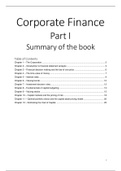Summary
Summary Corporate Finance MIDTERM
- Course
- Institution
- Book
Summary of the book Corporate Finance for the midterm for Finance for pre-master or Finance I. It contains chapter 1 till 12 (she will not ask questions about chapter 13)
[Show more]




